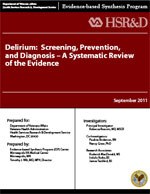
|
Principal Investigator: Rebecca Rossom, MD, MSCR Co-Investigators: Pauline Anderson, RN Nancy Greer, PhD Evidence-based Synthesis Program (ESP) Center, Minneapolis VA Medical Center Washington (DC): Department of Veterans Affairs; September 2011. |
Download PDF: Complete Report, Executive Summary, Report, Appendices
Delirium is a common syndrome in hospitalized or institutionalized adults. It is characterized by the acute onset of altered mental status, hallmarked by difficulty sustaining attention and a fluctuating course. Delirium frequently causes patients, families, and health care providers considerable distress. The incidence varies widely based on patient population, setting, and intensity of diagnostic ascertainment with reported values of 10% to over 80%. Delirium is associated with multiple serious outcomes including increased morbidity, length of hospital stay, healthcare costs, institutionalization, and mortality. In surgical settings, older adults and those with multiple medical conditions are at increased risk for postoperative delirium. Delirium may be under-recognized by healthcare providers and it can be difficult to resolve. Several brief "bedside" questionnaires and checklists exist that can help detect delirium earlier and among those with milder symptoms. Additionally, efforts to prevent the development of delirium in those at risk have been advocated. Medications (including sedatives, narcotics, and anticholinergic drugs), diseases and intercurrent illnesses (e.g., stroke, infection, shock, anemia), surgical procedures (especially orthopedic and cardiac surgery), and environmental factors (e.g., use of a bladder catheter, pain, and emotional stress) are all associated with delirium. Therefore, identifying and implementing effective strategies to prevent and detect delirium could improve clinical outcomes and resource utilization. Suggested strategies to prevent delirium include avoidance of psychoactive medications, pharmacologic interventions to decrease risk, and single- or multi-component non-pharmacologic interventions (including use of music, mobilization, fluid and nutrition management, and orientation and cognitive stimulation).
This review was undertaken to evaluate the effectiveness of screening for delirium, the effectiveness and harms of strategies to prevent delirium, and the comparative diagnostic accuracy of tools used to detect delirium. Specifically, we addressed the following key questions: